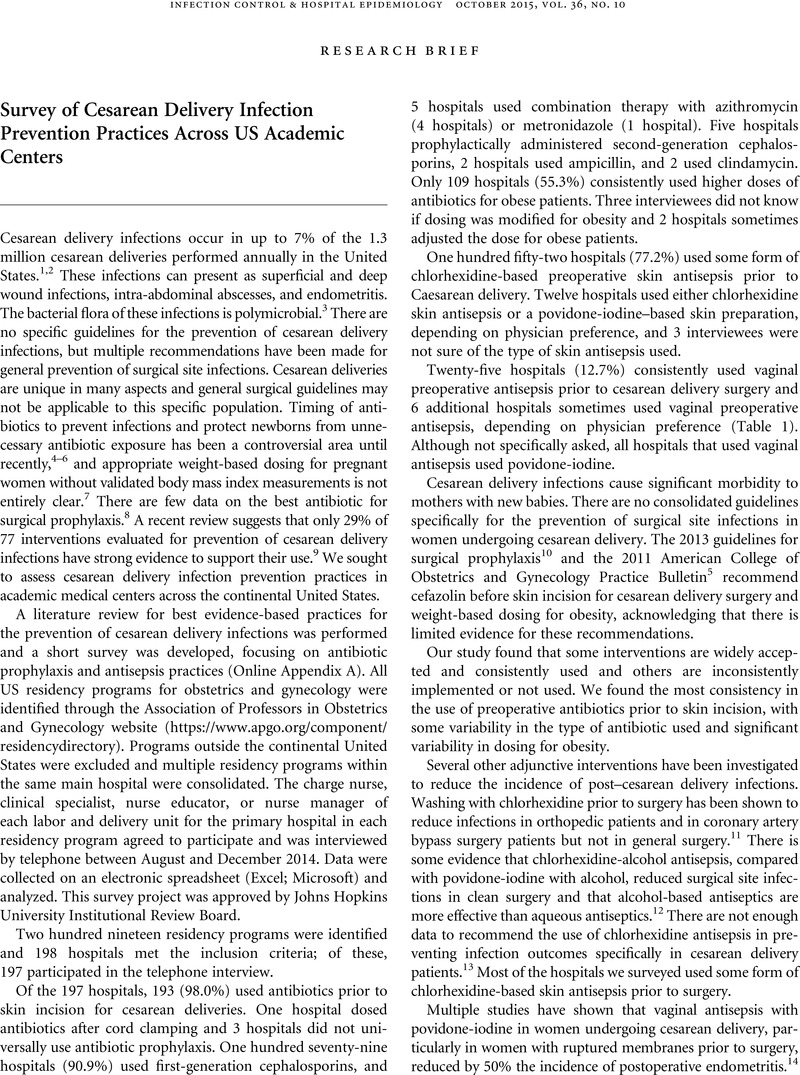Crossref Citations
This article has been cited by the following publications. This list is generated based on data provided by Crossref.
Martin, EK
Beckmann, MM
Barnsbee, LN
Halton, KA
Merollini, KMD
and
Graves, N
2018.
Best practice perioperative strategies and surgical techniques for preventing caesarean section surgical site infections: a systematic review of reviews and meta‐analyses.
BJOG: An International Journal of Obstetrics & Gynaecology,
Vol. 125,
Issue. 8,
p.
956.
Badia, Josep M.
Casey, Anna L.
Rubio-Pérez, Inés
Crosby, Cynthia
Arroyo-García, Nares
and
Balibrea, José M.
2018.
A survey to identify the breach between evidence and practice in the prevention of surgical infection: Time to take action.
International Journal of Surgery,
Vol. 54,
Issue. ,
p.
290.
Badia, Josep M.
Rubio-Pérez, Inés
López-Menéndez, José
Diez, Cecilia
Al-Raies Bolaños, Bader
Ocaña-Guaita, Julia
Meijome, Xose M.
Chamorro-Pons, Manuel
Calderón-Nájera, Ramón
Ortega-Pérez, Gloria
Paredes-Esteban, Rosa
Sánchez-Viguera, Cristina
Vilallonga, Ramon
Picardo, Antonio L.
Bravo-Brañas, Elena
Espin, Eloy
and
Balibrea, José M.
2020.
The persistent breach between evidence and practice in the prevention of surgical site infection. Qualitative study.
International Journal of Surgery,
Vol. 82,
Issue. ,
p.
231.
Badia, Josep M.
Casey, Anna L.
Rubio-Pérez, Inés
Arroyo-García, Nares
Espin, Eloy
Biondo, Sebastiano
and
Balibrea, José M.
2020.
Awareness of Practice and Comparison with Best Evidence in Surgical Site Infection Prevention in Colorectal Surgery.
Surgical Infections,
Vol. 21,
Issue. 3,
p.
218.
Badia, Josep M.
Amillo Zaragüeta, Mireia
Rubio-Pérez, Inés
Espin-Basany, Eloy
González Sánchez, Carmen
and
Balibrea, José M.
2022.
¿Qué hemos aprendido de las encuestas de la AEC, AECP y del Observatorio de Infección en Cirugía? Cumplimiento de las medidas de prevención de infección postoperatoria y comparación con las recomendaciones de la AEC.
Cirugía Española,
Vol. 100,
Issue. 7,
p.
392.
Badia, Josep M.
Amillo Zaragüeta, Mireia
Rubio-Pérez, Inés
Espin-Basany, Eloy
González Sánchez, Carmen
Balibrea, José M.
Al-Raies Bolaño,, Bader
Bravo-Brañas, Elena
Calderón Nájera, Ramón
Chamorro Pons, Manuel
Diez, Cecilia
Meijome, Xosé M.
López Menéndez, José
Ocaña Guaita, Julia
Ortega Pérez, Gloria
Paredes Esteban, Rosa
Picardo, Antonio L.
Sánchez Viguera, Cristina
and
Vilallonga, Ramón
2022.
What have we learned from the surveys of the AEC, AECP and the Observatory of Infection in Surgery? Compliance with postoperative infection prevention measures and comparison with the AEC recommendations.
Cirugía Española (English Edition),
Vol. 100,
Issue. 7,
p.
392.
Zielińska, Małgorzata
Pawłowska, Agnieszka
Orzeł, Anna
Sulej, Luiza
Muzyka-Placzyńska, Katarzyna
Baran, Arkadiusz
Filipecka-Tyczka, Dagmara
Pawłowska, Paulina
Nowińska, Aleksandra
Bogusławska, Joanna
and
Scholz, Anna
2023.
Wound Microbiota and Its Impact on Wound Healing.
International Journal of Molecular Sciences,
Vol. 24,
Issue. 24,
p.
17318.
Erritty, Matthew
Hale, Joann
Thomas, James
Thompson, Anna
Wright, Ria
Low, Anna
Carr, Megan
George, Richard
Williams, Lisa
Dumitrescu, Alexandra
Rees, Jacqui
Irukulla, Shashi
Fry, Christopher H.
Fluck, David
and
Han, Thang S.
2023.
Reduction of adverse outcomes from cesarean section by surgical‐site infection prevention care bundles in maternity.
International Journal of Gynecology & Obstetrics,
Vol. 161,
Issue. 3,
p.
963.
Styczynski, Ashley
Amin, Mohammed Badrul
Hoque, Kazi Injamamul
Parveen, Shahana
Md Pervez, Abu Faisal
Zeba, Dilruba
Akhter, Akhi
Pitchik, Helen
Islam, Mohammad Aminul
Hossain, Muhammed Iqbal
Saha, Sumita Rani
Gurley, Emily S.
and
Luby, Stephen
2024.
Perinatal colonization with extended-spectrum beta-lactamase-producing and carbapenem-resistant Gram-negative bacteria: a hospital-based cohort study.
Antimicrobial Resistance & Infection Control,
Vol. 13,
Issue. 1,



